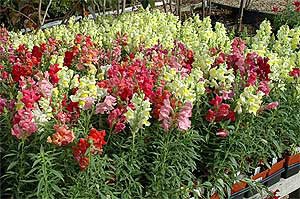The allure of those beautiful annuals calling our name as we drive by the nursery, or pull into the home improvement store can be too much. We probably didn’t even have flowers on our shopping list. Now I’m as weak as the next guy when it comes to impulse buying, and I’m an admitted plantaholic. But, before any new flowers or plants go home to my garden, they must pass a tough inspection.

Fortunately for me, many happy gardeners buy up all the annuals in full bloom, the ones with the most blooms currently on display. I on the other hand, use these flowers as a guide, but proceed to purchase the plants that have yet to bloom, or are just starting to bud. These are the plants that will look great a few weeks from now in my garden, when the others may have already fizzled out. It takes a lot of energy to put out flower buds. I prefer that energy to go into making a bigger stronger root system first, rather than trying to spread plant resources in too many directions.
Now I realize annuals are easy plants to grow, and they’re usually very productive for the few weeks or months that they are on display. But unless I need color impact today, I’ll opt for disbudding an annual in full bloom, or look for ones yet to flower.
Next, I check for pest damage. I usually have enough pests in my garden already, and the last thing I want to do is bring more home! Be sure to look all around the plants, especially under the leaves where most pests like to hide. Look for signs of discolored leaves, or ones that look like they’ve been chewed on, or have holes. These plants are likely hosts for any number of pests. Bring these plants home, and you’ve just unwittingly invited a whole host of other problems.
As I inspect the leaves, I’m also looking for disease problems. Again a discolored, or spotted leaf, is a good sign of problems. It may be that the plant has simply had too little or too much water, or light. However, disease symptoms can show the same signs. Assuming I have a choice of which plants I’m buying, and I usually do, the plants that show stress don’t come home with me. Although it may be a very correctable problem, why take the chance when choices abound.
The next inspection point comes with the general form of the plant. Is it short and stocky; full looking? Or, is it tall and leggy, kind of gangly? I want the compact plant. This one matured under the best conditions, and I’d rather not take the time to rehabilitate a plant that has suffered. These may continue to do so in my garden.
Lastly, how do the roots look? Are they fully developed, without being root bound? Root bound plants can become stunted, and without some help from you at planting time, may never break the cycle. The plant will simply languish at best.
This sounds like a tough regime for little annuals to pass the test, and I admit, most of these problems are correctable with a little knowledge. But I say, if you’re spending good money, then being a bit more selective at the point of purchase will pay big dividends in your garden.